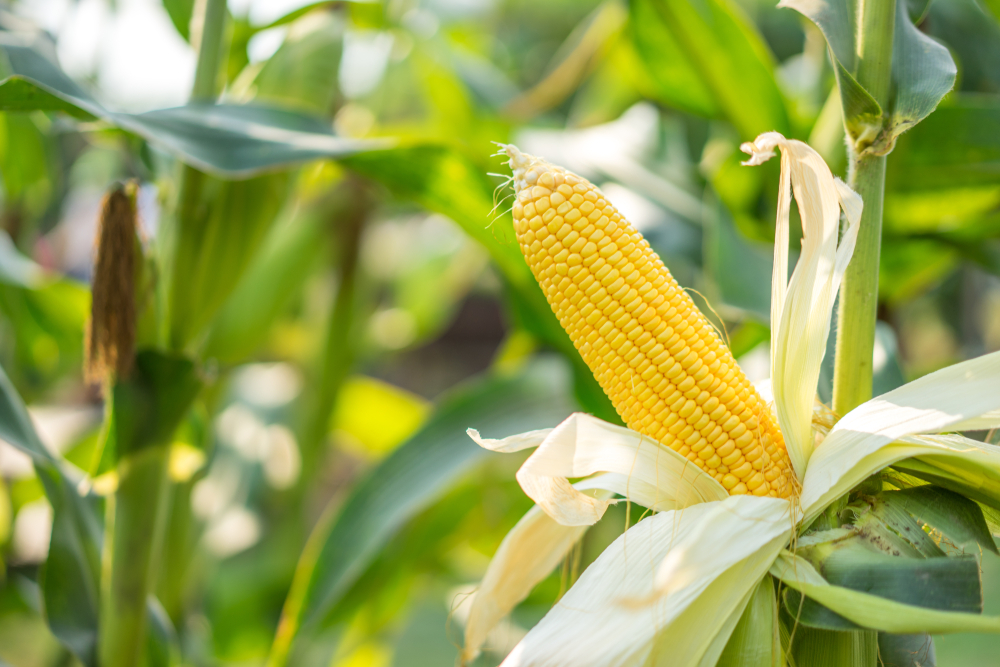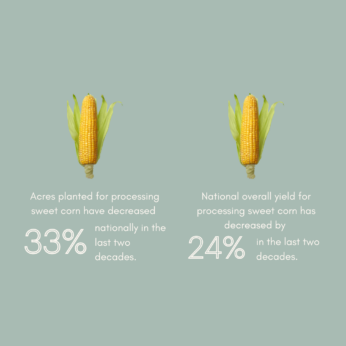New research shows a drop in processing sweet corn production in the Midwest and Pacific Northwest over the past 27 years.

Sweet corn destined for the freezer or the canned food aisle has been steadily decreasing over the last three decades, according to a new study published in HortScience. Researchers from the University of Illinois Urbana-Champaign (UIUC) analyzed a 27-year data set spanning 20,000 sweet corn fields across four states. Between 1992 and 2018, this data set tracked things such as yield, acres planted and hybrid lifespan.
Over that time, processing sweet corn trends have seen an overall reduction in acres planted and in production. This study looked at trends independent of causes, but the researchers’ previous findings suggest a direct link to climate change, since higher temperatures were associated with drops in yield. The study also says that declines could also be partially consumer-driven. Since processing corn is grown for canning or freezing, not eaten fresh on the cob, a consumer preference for fresh corn could be contributing to the waning numbers.

Statistics per USDA.
The fields were grouped into five categories based on region and water sourcing—Illinois irrigated, Illinois rainfed, Washington irrigated, Minnesota rainfed and Wisconsin irrigated. The researchers saw a decline in acres planted in every category, and Wisconsin’s fields were the only ones to see an increase in yield. By the end of the data set, Wisconsin was producing more corn on less acreage than at the beginning of data collection. Although this study didn’t look at causation, this could possibly be linked to those fields being irrigated instead of rainfed.
“When you have some kind of extreme weather events, whether it’s excessive rainfall, excessive temperatures or temperatures and drought, those yield deviations are greatest under rainfed conditions,” says Martin Williams, ecologist with the US Department of Agriculture (USDA) Agricultural Research Service (ARS) and corresponding author of this study. Rainfed fields were more directly influenced by swings in the weather, particularly when it came to water supply. For example, the rainfed fields of Illinois saw the sharpest declines.
This is a big deal, says Williams, because the most important thing when it comes to processing sweet corn is consistency.
“You want those folks producing phenomenal yields and …know that they’re going to be able to deliver that,” says Williams. “(Instead of) something that deviates from what they’re expecting for the season.”
One potential avenue toward that consistency is continuing to improve the stress tolerance of the cultivars used. Commercial sweet corn operations use hybrid corn, which can be bred to meet environmental obstacles with more stability.
“You don’t necessarily need a flashy hybrid,” says Williams. “You want what they call ‘workhorse hybrids’ that do well, are less influenced by environmental swings and more hardwired to perform at a certain level.”
The cultivars in use now won’t necessarily be the ones performing well decades down the road, he says.
“It gives you a little pause—what do we need to be doing now so we can ensure profitability and productivity into the future?”
The truth is most folks can’t stand corn anymore unless they grow it themselves. They see corn in general and think roundup ready or fungicide. They don’t want there sweet corn sprayed.
A major factor not mentioned is that processing plants have been closing ever since NAFTA was passed in 1994. The plants were heavily reliant on immigrant workers from Mexico and once the trade restrictions were eliminated it was more profitable to simply move production to Mexico and later to Central America than to bring workers to the Midwest and the Northwest. Also consumer preferences were changing with frozen vegetable consumption increasing and canned vegetable consumption decreasing. This meant that the canneries closed, and again the new frozen vegetable processing plants were often built south of the border.
Ensuring profitability and productivity is important, but don’t forget flavor! In order to get more product onto a larger truck and drive it to processing or selling point, Taste has been forgotten in so many products, and seemingly bred out in order to get them to a warehouse. If you want people to continue eating/purchasing your product it must taste good!
Consider those strawberries and tomatoes that people are trying to grow in their yards because the store-purchased ones have no flavor!!!
A 33% drop in total acres planted happened at the same time as a 24% drop in total yield. That is a 13.4% increase in production per acre planted. Is that a problem?
The problem with corn is corn syrup and the fact that it is in evetything.
A misleading title. Sweet corn is not really on a decline. It’s frozen and canned sweet corn that is on a decline. This is a reflection of consumers shifting from processed vegetables in general to fresh. Canned and frozen vegetables are on the decline in general, as more are buying fresh product.
I grow sweet corn myself. If I buy it, I buy local. Much better than processed.
Farmers have been cultivating maize in India for a long time, we have not found a suitable market for it where farmers can get good prices for maize.
Quit giving us feed corn for consumption.
The corn they sell today versus when we had field seed instead of this gmo junk was more nutritional, soft, and sweet. Even the feed corn back in the day was better than the junk they try to convince you 8s real corn.
Man messed with it and took the perfection right out of it!